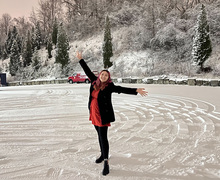Opinion: Hurricane Helene foreshadows our climate’s future
Sam Maller | Daily Orange File Photo
Our columnist critiques the lack of proactive action taken by government officials to protect at-risk Americans from the devastating effects of climate change and weather events we’ve seen lately on the East Coast.
Get the latest Syracuse news delivered right to your inbox.
Subscribe to our newsletter here.
It’s already October, and soon enough, winter will be in full swing. Although colder weather reminds me of the holidays, it has become abundantly clear that a snow-dominated season is becoming a thing of the past.
This past winter was Syracuse’s warmest, with the average temperature falling at 34.2 degrees — 7.3 degrees above what is considered central New York’s normal threshold for the season. Predictions for this upcoming winter show a similar pattern: above average heat with above average precipitation.
Rising temperatures can be directly attributed to man-made causes of climate change, such as the releasing of large amounts of greenhouse gasses into the atmosphere and the increased reflectivity of the sun’s energy from activities like road construction and deforestation.
But Syracuse University’s decrease in snowfall is not the only evidence of climate change. At the end of September, Hurricane Helene ravaged Florida and the southern Appalachian region of the United States as a Category 4 storm, leaving at least 227 dead and hundreds of thousands without power and clean water. A similarly devastating storm, Milton, approached the Tampa Bay Area of Florida Wednesday.
Brad Johnson, a geologist and landslide expert at Davidson College in North Carolina, told Politico that many experts predicted the potential for this level of devastation from natural disasters about 30 years ago as a result of climate change. Helene, in particular, experienced up to 50% of its rainfall as a result of global warming.
Despite this, little action was taken. State governments did not invest in disaster protection for the Appalachian region, leaving many residents in positions unable to invest in protections such as flood insurance. This can no longer be our reality.

Alex Levy | Contributing Designer
It’s abundantly clear that ignoring the advice of scientists to work toward reversing the effects of climate change not only decreases our quality of life, but puts our lives at risk. Disasters like Helene are not an anomaly — they’re a foreshadowing of what will come if we continue to deny the reality of our climate situation.
Syracuse is not immune. As for now, we may only be experiencing warmer winters and less snowfall, we need to understand that without action, the situation will only worsen.
Warmer temperatures naturally lead to an increased presence of rain. Due to central New York’s proximity to the Great Lakes and river valleys, the area will become more susceptible to severe inland flooding. The effects of unmanaged climate change are also echoed in the poor air and water quality. As a result of historical disparities and inequalities, certain communities feel these effects disproportionately compared to others.
A notable example is the history of Interstate 81 highway and how it racially divided Syracuse. The roadwork was constructed in the 1960s, straight through historically Black neighborhoods, thus displacing and forcing Black families to live closer to the interstate. People experienced increased air pollution, which has been connected to problems such as asthma and other lung issues — in fact, 13.4% of Black children experience asthma nationally compared to 7.3% of white children. Further, Black people are 75% more likely than white people to live near commercial facilities that contribute directly to pollution.
Current efforts to remove the I-81 aqueduct are a positive move forward toward achieving environmental justice for these communities. But we must do more.
Further ways students can learn more and help reduce the effects of climate change include educating themselves on the environmental issues currently impacting their communities. SU students may find the New York Civil Liberties Union’s environmental justice resources helpful.
Students should also contact their representatives and advocate on behalf of reliable sources calling for government action. While everyday efforts are helpful, it’s important to ensure our representatives are working to mitigate the situation on a more widespread scale.
It’s clear that climate change impacts numerous communities in a variety of severe, unequal ways. To ensure its effects don’t continue to persist, we must listen to the experts. We can no longer ignore them, especially when the evidence is right in front of us.
Grace “Gray” Reed is a senior majoring in magazine, news and digital journalism. Their column appears bi-weekly. They can be reached at greed04@syr.edu.
Published on October 9, 2024 at 11:38 pm






